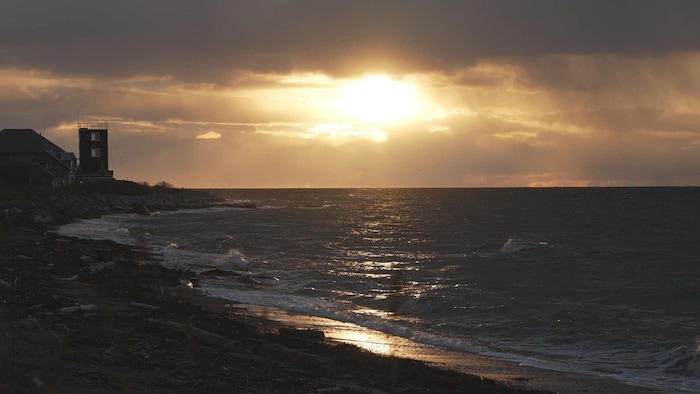The year 2023 was marked by heat waves in the waters of the estuary and Gulf of St. Lawrence. Temperature differences rarely seen in autumn, water that struggles to cool and little ice cover.

Open in full screen mode
The water temperature is constantly rising in the St. Lawrence estuary.
- André Bernard (View profile)André Bernard
Speech synthesis, based on artificial intelligence, makes it possible to generate spoken text from written text.
We are at the end of October, in Mont-Joli, on the banks of the Saint-Laurent River. The weather is gray and cool. The wind is light. It’s 3°C. Normal weather for the season.
In the water, it's quite the opposite. The temperature there is almost four times higher. It reached 11°C, which we hadn't seen for years, on the eve of November.
These are temperatures that we should find at the peak of summer. That’s 5°C above what it should be. Instead of being at 6°C (end of October), we find ourselves at 11°C. These are big numbers, underlines Peter Galbraith, researcher in physical oceanography at the Maurice-Lamontagne Institute, in Mont-Joli.
Peter Galbraith and his colleagues from Quebec and the Atlantic provinces have been collecting and collating data for almost 30 years on the temperature cycle of the waters of the Gulf and the estuary of St. Lawrence.
Valuable data which then goes to the Maurice-Lamontagne Institute, in Mont-Joli, to be collected and analyzed.
Peter Galbraith is a researcher in physical oceanography at the Maurice-Lamontage Institute.
A few days ago, Peter Galbraith presented the results of the observations of the year 2023. What is striking are the successive heat waves in the waters of the Gulf and the estuary.
In June, on this side of the Atlantic, the waters were cold, while they were abnormally warm in Europe.
But everything switched to July. Hot, scorching air in eastern Canada heated surface waters at lightning speed. Warm temperature anomalies (red) covered the entire Gulf and Estuary – the temperature anomaly describes the temperature departure from those of the last 30 years.
1/4
Warm temperature anomalies (in red) in the Gulf and Estuary of St. Lawrence during the week of June 25 to July 1, 2023
Warm temperature anomalies (in red) in the Gulf and Estuary of the St. Lawrence during the week of June 25 to July 1, 2023
Photo album: Temperature of the St. Lawrence
.
After a slight dissipation of the heat in August, the Gulf and the estuary of the St. Lawrence warmed up like never before in September. A new unexpected marine heat wave hit the coast and its waters.
All September, in the estuary and the north west of the Gulf, we had the hottest temperatures of all satellite data for 42 years, so on average 5°C warmer, recalls Peter Galbraith.
An anomaly of 5°C corresponds to a value so high that the scale lacked colors to convey the intensity of the warming.
Our color palette turns dark red from 2.5°C warmer than climatology. We were well above it in different places. We would have had to double our color palette to be able to begin to discern how hot it was.
A quote from Peter Galbraith, researcher in physical oceanography at the Maurice-Lamontagne Institute
On a global scale, the temperature of surface waters in oceans, like air temperatures, reached records in 2023.
The following graph shows how surface water temperatures (apart from the polar regions) have remained at levels outside of what had been recorded in past years. The El Niño climate phenomenon may have played a role, but the general warming trend is well established.
Water surface temperature on a planetary scale
Daily water surface temperatures for the year 2023 in the world (in orange) compared to the years 1981 to 2023.
In the deep waters of the Gulf, about 300 meters below the surface, the temperature remained at 6.9°C. This is twice as much as a hundred years ago, when the temperature was around 3.5°C.
The phenomenon is attributable to changes in the path of ocean currents. The St. Lawrence receives a greater share of the warm waters of the Gulf Stream than before.
In fact, the layers of water that flow overlap all heat up over time.
The superposition of layers of water in the St. Lawrence .
In 2023, the cold intermediate layer, which builds from the previous winter's ice, was among the four warmest observed in a dozen years.
Moreover, the relatively mild temperatures of the current winter have allowed the surface waters of the Gulf and the estuary to retain some of their heat and remain above the freezing point of salt water – around -1.8°C. So much so that the ice was almost absent from the St. Lawrence, again on Thursday, the day of the most recent data.
It changes quickly, warns Peter Galbraith. Significant changes in the presence of ice have already been observed in just a few years of sampling.
This is not a future climate change for the Gulf of St. Lawrence, it is a climate change that we are feeling now.
A quote from Peter Galbraith, oceanography researcher physics at the Maurice-Lamontagne Institute
From the shore, it is difficult to perceive these temperature changes in the waters of the St. Lawrence.
However, they are in the process of disrupting a large part of the ecosystem of the Gulf and the estuary because the species that live there are often much more sensitive than us to the slightest difference in water temperature.
A report by André Bernard and Yanick Rose on the rise in temperatures in the estuary and the Gulf of St. Lawrence will be presented at the #x27;show Découverte broadcast Sunday at 6 h< /em> 30 on HERE TELE and at 10 h on HERE Explora, and Saturday at 7 h 30 on HERE< /strong> RDI.
- André Bernard (View profile)André BernardFollow

